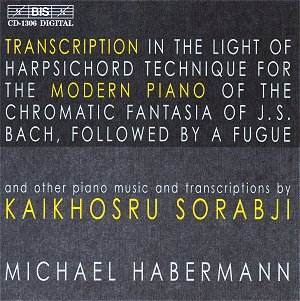Kaikhosru Shapurji Sorabji was one of the great individuals
of music. His magnum opus, the Opus Clavicembalisticum, still
inspires awe and not a little fear in the hearts of all sane pianists,
and remains his most (in)famous work (Geoffrey Douglas Madge recorded
this on BIS CD1062-4).
On this disc the pianist is Michael Habermann,
who specialises in Sorabji’s music and has given a number of first
performances (he also provides fascinating liner notes). As a
labour of love this can hardly be bettered, for the 1 hour 8 minutes
playing time is gripping from first note to last.
One would have thought that Ravel’s Rapsodie
espagnole was heady enough, but obviously not for Sorabji
(Habermann quotes a letter in which Sorabji also refers to a transcription
of the Closing Scene of Richard Strauss’ Salome … now that
I would like to hear). The Ravel/Sorabji Rapsodie espagnole
was premièred by Habermann in Stockholm in 1998 and is
required listening. Sorabji takes Ravel’s individual sound-world
and filters it through his own, so that Ravel’s harmonies become
more cloudy than veiled, eventually becoming more and more obscure
and tending towards clusters. The finale, ‘Feria’, is tough in
the extreme. Habermann responds with breathtaking aplomb. This
is such an exhilarating performance, I suggest the listener takes
a break after it!.
Habermann refers to the Passeggiata Veneziana
as, ‘one of Sorabji’s greatest compositions’, stating that, ‘it
is the most challenging of the transcriptions in that the original
material serves as a springboard for fantastic escapades’. It
certainly is no walk-over of a piece, but complementing the virtuosity
of the notes is the virtuosity of the composer, whether in the
stellar evocations of the opening or in the emergence of the theme
(the ‘Barcarolle’ from Offenbach’s Contes d’Hoffmann) from
decadently perfumed harmonies. It is typical of this composer
in that over-the-top technical complexities (in the ‘Tarantella’
section) are immediately juxtaposed with extremely decadent passages
(the tempo/expression mark in the latter part is, ‘Notturnino.
Sonnolento, languidamente voluttuoso. Sonorità sempre piena
e calorosa’).
The solo piano version of Variation 56 from the
Symphonic Variations is based on the ‘graveyard’ finale
of Chopin’s Second Piano Sonata (1839). The same ominous movement
is there, but ‘opened out’. This is more of a transformation of
Chopin than anything else and makes for tremendously exciting
listening. Given Sorabji’s penchant for extremes, it should come
as no surprise that the Quasi habanera is really quite
sleazy.
The Bach/Sorabji item shows a firm and confident
hand at work (the fugue that follows the Chromatic Fantasia,
referred to in the title, is the D minor, BWV948). Habermann is
particularly successful in projecting the fugue’s granite-like
sonorities.
Finally, the Pasticcio capriccioso on
Chopin’s Op. 64 No. 1. It is difficult to top Habermann’s own
commentary: ‘Embellishment and added-note harmonies assume mammoth
proportions. The ending of the Pasticcio is almost catastrophic
in nature’. It is an ideal way in which to end the disc, exuding
style and humour whilst simultaneously prickling with difficulties.
BIS are to be congratulated on their adventurous
programming. This disc may immediately seem to be for pianophiles
only, but in fact it offers a fascinating window into Sorabji’s
unique world.
Colin Clarke
